Abstract
Most of the composites and sealants used in dentistry are based on bisphenol A diglycidylether methacrylate (Bis-GMA). Reports revealed that in situ polymerization is not complete and that free monomers can be detected by different analytic methods. Concerns about the estrogenicity of bisphenol A (BPA) and other aromatic components leached from commercial products have been expressed. We studied biphenolic components eluted from seven composites and one sealant before and after in vitro polymerization using HPLC and gas chromatography/mass spectrometry and we investigated how pH modifications affect the leaching of these components. We found BPA (maximal amount 1.8 microg/mg dental material), its dimethacrylate derivative (Bis-DMA, 1.15 microg/mg), bisphenol A diglycidylether (6. 1 microg/mg), Bis-GMA (2.0 microg/mg), and ethoxylate and propoxylate of bisphenol A in media in which samples of different commercial products were maintained under controlled pH and temperature conditions. Our results confirm the leaching of estrogenic monomers into the environment by Bis-GMA-based composites and sealants in concentrations at which biologic effects have been demonstrated in in vivo experimental models. The main issue with implications for patient care and dentist responsibility is to further determine the clinical relevance of this estrogenic exposure.
Full text
PDF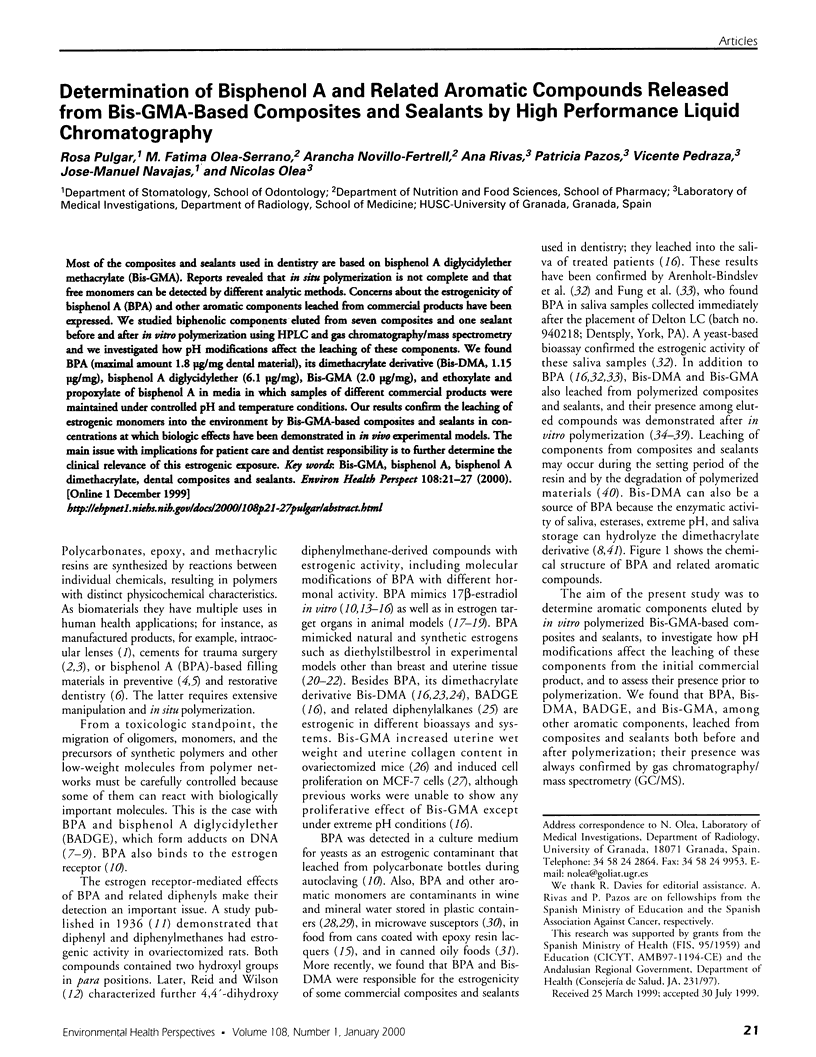
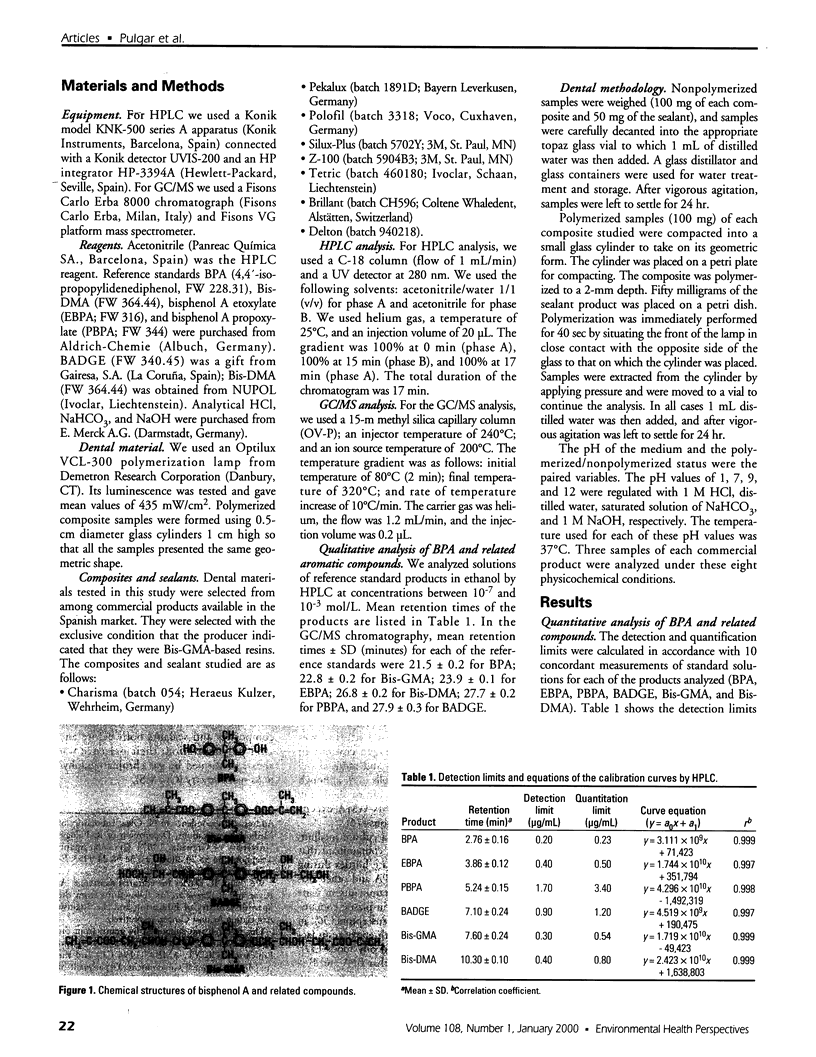
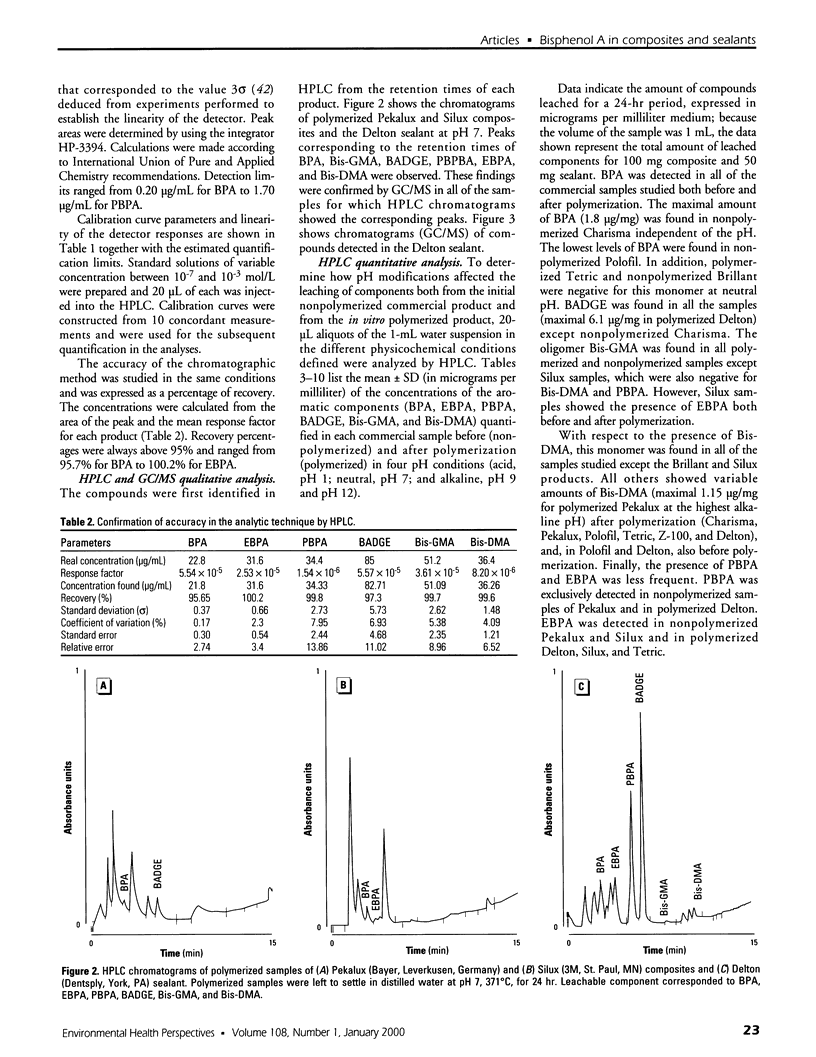
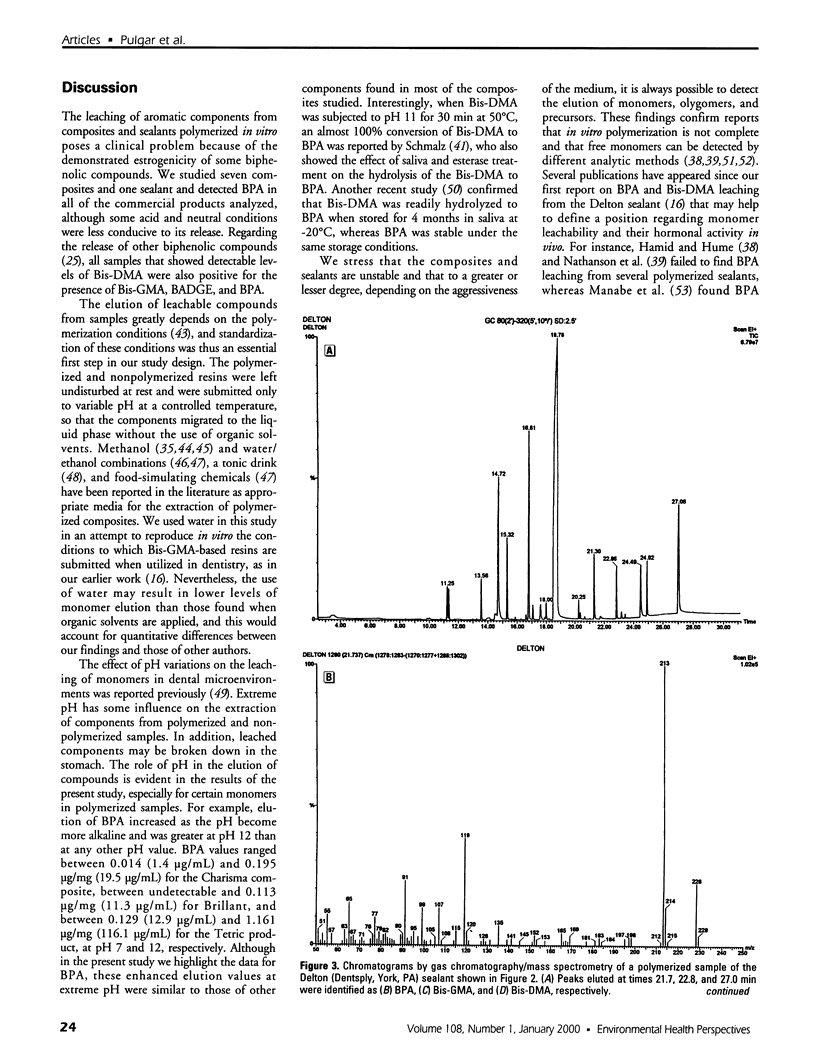
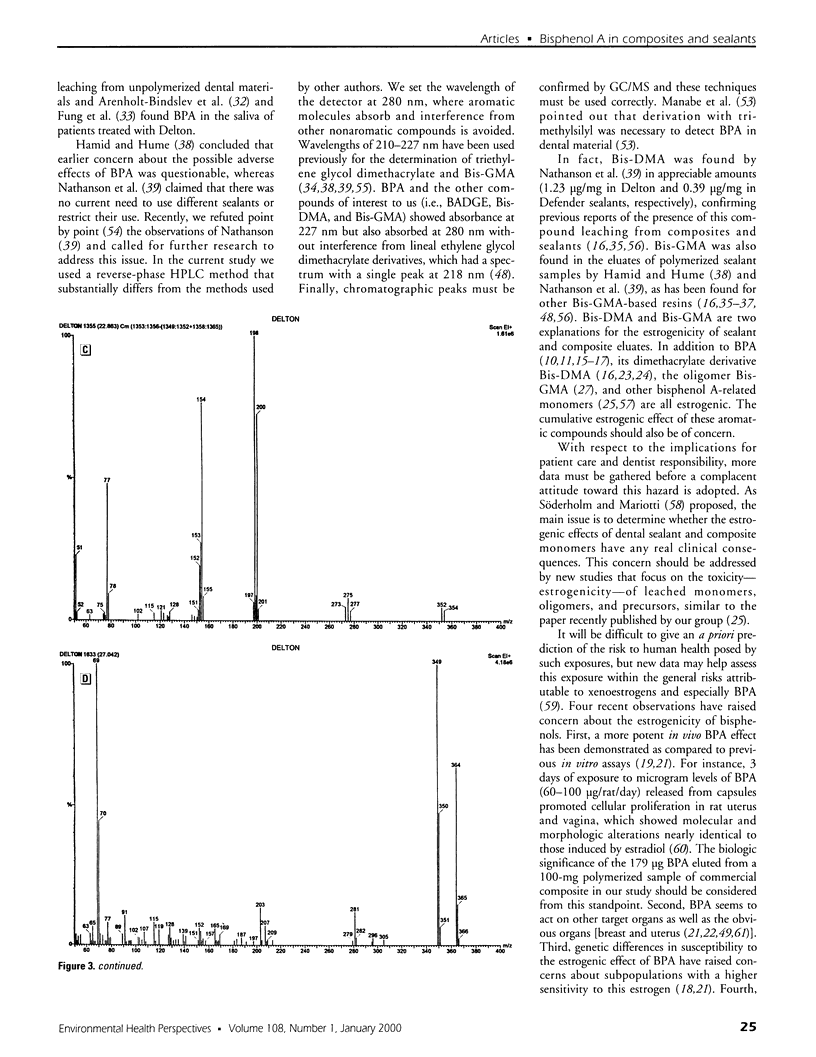
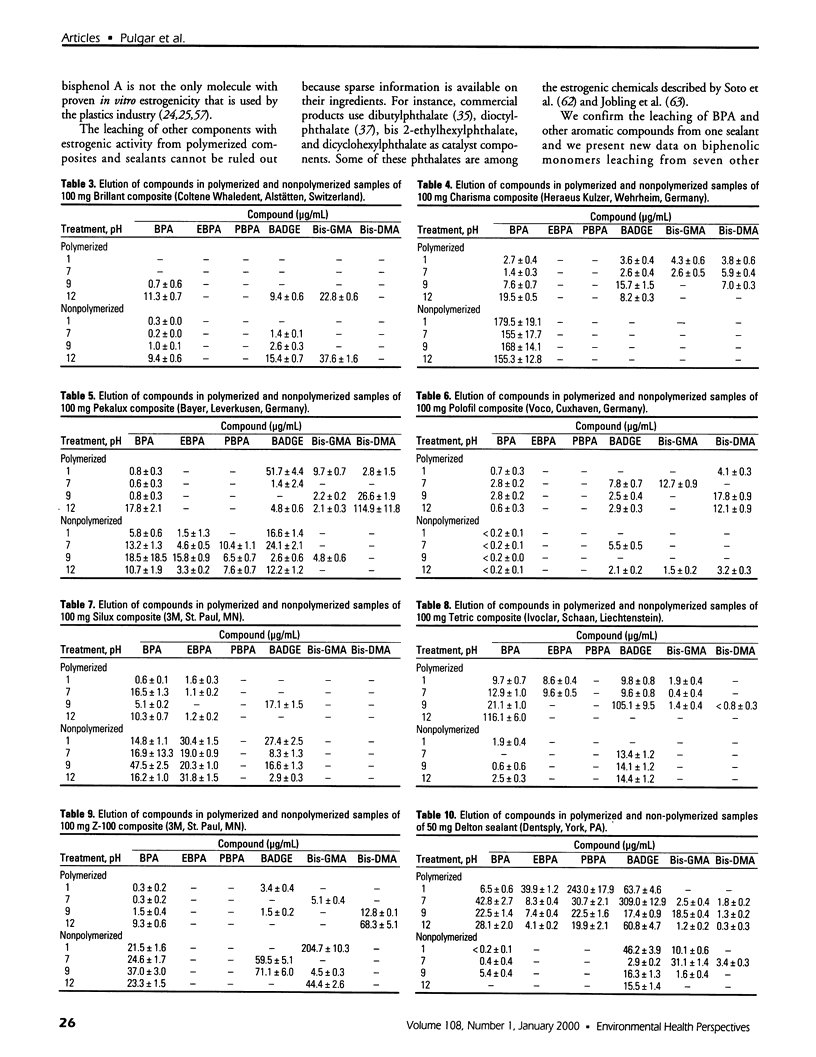
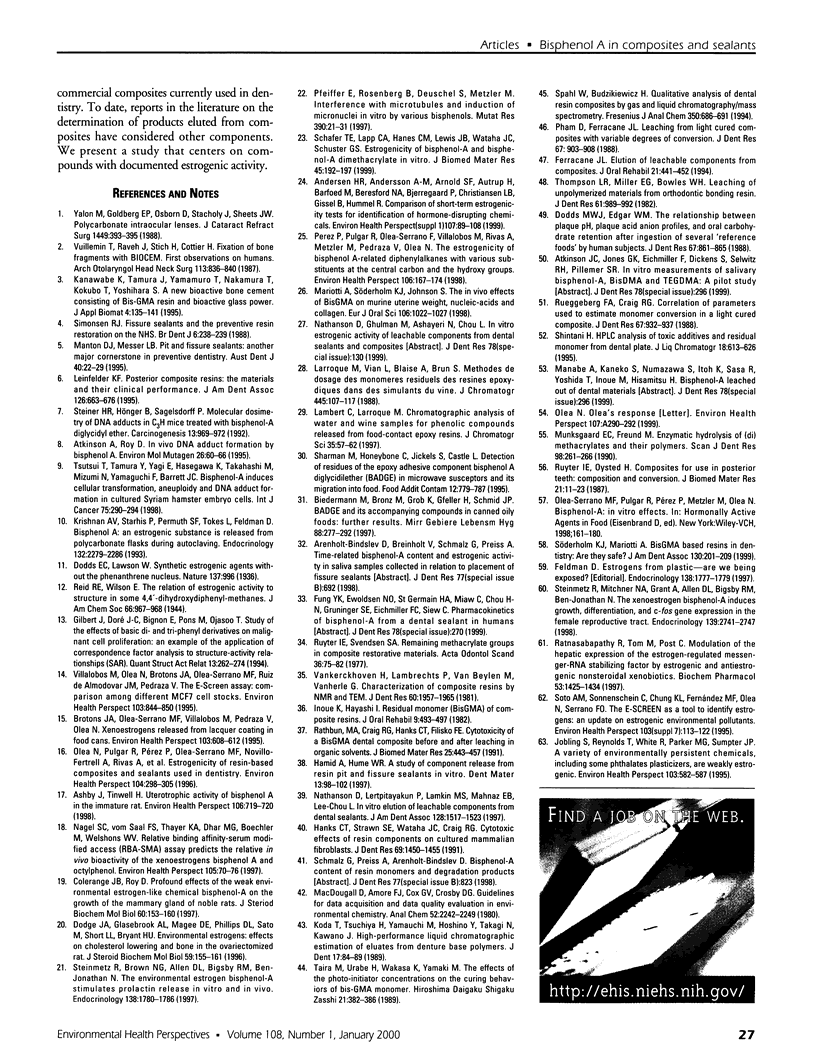
Images in this article
Selected References
These references are in PubMed. This may not be the complete list of references from this article.
- Andersen H. R., Andersson A. M., Arnold S. F., Autrup H., Barfoed M., Beresford N. A., Bjerregaard P., Christiansen L. B., Gissel B., Hummel R. Comparison of short-term estrogenicity tests for identification of hormone-disrupting chemicals. Environ Health Perspect. 1999 Feb;107 (Suppl 1):89–108. doi: 10.1289/ehp.99107s189. [DOI] [PMC free article] [PubMed] [Google Scholar]
- Ashby J., Tinwell H. Uterotrophic activity of bisphenol A in the immature rat. Environ Health Perspect. 1998 Nov;106(11):719–720. doi: 10.1289/ehp.98106719. [DOI] [PMC free article] [PubMed] [Google Scholar]
- Atkinson A., Roy D. In vivo DNA adduct formation by bisphenol A. Environ Mol Mutagen. 1995;26(1):60–66. doi: 10.1002/em.2850260109. [DOI] [PubMed] [Google Scholar]
- Brotons J. A., Olea-Serrano M. F., Villalobos M., Pedraza V., Olea N. Xenoestrogens released from lacquer coatings in food cans. Environ Health Perspect. 1995 Jun;103(6):608–612. doi: 10.1289/ehp.95103608. [DOI] [PMC free article] [PubMed] [Google Scholar]
- Colerangle J. B., Roy D. Profound effects of the weak environmental estrogen-like chemical bisphenol A on the growth of the mammary gland of Noble rats. J Steroid Biochem Mol Biol. 1997 Jan;60(1-2):153–160. doi: 10.1016/s0960-0760(96)00130-6. [DOI] [PubMed] [Google Scholar]
- Dodds M. W., Edgar W. M. The relationship between plaque pH, plaque acid anion profiles, and oral carbohydrate retention after ingestion of several 'reference foods' by human subjects. J Dent Res. 1988 May;67(5):861–865. doi: 10.1177/00220345880670051301. [DOI] [PubMed] [Google Scholar]
- Dodge J. A., Glasebrook A. L., Magee D. E., Phillips D. L., Sato M., Short L. L., Bryant H. U. Environmental estrogens: effects on cholesterol lowering and bone in the ovariectomized rat. J Steroid Biochem Mol Biol. 1996 Oct;59(2):155–161. doi: 10.1016/s0960-0760(96)00104-5. [DOI] [PubMed] [Google Scholar]
- Feldman D. Estrogens from plastic--are we being exposed? Endocrinology. 1997 May;138(5):1777–1779. doi: 10.1210/endo.138.5.5213. [DOI] [PubMed] [Google Scholar]
- Ferracane J. L. Elution of leachable components from composites. J Oral Rehabil. 1994 Jul;21(4):441–452. doi: 10.1111/j.1365-2842.1994.tb01158.x. [DOI] [PubMed] [Google Scholar]
- Hamid A., Hume W. R. A study of component release from resin pit and fissure sealants in vitro. Dent Mater. 1997 Mar;13(2):98–102. doi: 10.1016/s0109-5641(97)80018-8. [DOI] [PubMed] [Google Scholar]
- Hanks C. T., Strawn S. E., Wataha J. C., Craig R. G. Cytotoxic effects of resin components on cultured mammalian fibroblasts. J Dent Res. 1991 Nov;70(11):1450–1455. doi: 10.1177/00220345910700111201. [DOI] [PubMed] [Google Scholar]
- Inoue K., Hayashi I. Residual monomer (Bis-GMA) of composite resins. J Oral Rehabil. 1982 Nov;9(6):493–497. doi: 10.1111/j.1365-2842.1982.tb01039.x. [DOI] [PubMed] [Google Scholar]
- Jobling S., Reynolds T., White R., Parker M. G., Sumpter J. P. A variety of environmentally persistent chemicals, including some phthalate plasticizers, are weakly estrogenic. Environ Health Perspect. 1995 Jun;103(6):582–587. doi: 10.1289/ehp.95103582. [DOI] [PMC free article] [PubMed] [Google Scholar]
- Koda T., Tsuchiya H., Yamauchi M., Hoshino Y., Takagi N., Kawano J. High-performance liquid chromatographic estimation of eluates from denture base polymers. J Dent. 1989 Apr;17(2):84–89. doi: 10.1016/0300-5712(89)90137-1. [DOI] [PubMed] [Google Scholar]
- Krishnan A. V., Stathis P., Permuth S. F., Tokes L., Feldman D. Bisphenol-A: an estrogenic substance is released from polycarbonate flasks during autoclaving. Endocrinology. 1993 Jun;132(6):2279–2286. doi: 10.1210/endo.132.6.8504731. [DOI] [PubMed] [Google Scholar]
- Lambert C., Larroque M. Chromatographic analysis of water and wine samples for phenolic compounds released from food-contact epoxy resins. J Chromatogr Sci. 1997 Feb;35(2):57–62. doi: 10.1093/chromsci/35.2.57. [DOI] [PubMed] [Google Scholar]
- Larroque M., Vian L., Blaise A., Brun S. Méthodes de dosage des monomères résiduels des résines époxydiques dans des simulants du vin. J Chromatogr. 1988 Jul 8;445(1):107–117. doi: 10.1016/s0021-9673(01)84512-x. [DOI] [PubMed] [Google Scholar]
- Leinfelder K. F. Posterior composite resins: the materials and their clinical performance. J Am Dent Assoc. 1995 May;126(5):663-4, 667-8, 671-2 passim. doi: 10.14219/jada.archive.1995.0247. [DOI] [PubMed] [Google Scholar]
- Manton D. J., Messer L. B. Pit and fissure sealants: another major cornerstone in preventive dentistry. Aust Dent J. 1995 Feb;40(1):22–29. doi: 10.1111/j.1834-7819.1995.tb05608.x. [DOI] [PubMed] [Google Scholar]
- Mariotti A., Söderholm K. J., Johnson S. The in vivo effects of bisGMA on murine uterine weight, nucleic acids and collagen. Eur J Oral Sci. 1998 Dec;106(6):1022–1027. doi: 10.1046/j.0909-8836.1998.eos106607.x. [DOI] [PubMed] [Google Scholar]
- Munksgaard E. C., Freund M. Enzymatic hydrolysis of (di)methacrylates and their polymers. Scand J Dent Res. 1990 Jun;98(3):261–267. doi: 10.1111/j.1600-0722.1990.tb00971.x. [DOI] [PubMed] [Google Scholar]
- Nagel S. C., vom Saal F. S., Thayer K. A., Dhar M. G., Boechler M., Welshons W. V. Relative binding affinity-serum modified access (RBA-SMA) assay predicts the relative in vivo bioactivity of the xenoestrogens bisphenol A and octylphenol. Environ Health Perspect. 1997 Jan;105(1):70–76. doi: 10.1289/ehp.9710570. [DOI] [PMC free article] [PubMed] [Google Scholar]
- Nathanson D., Lertpitayakun P., Lamkin M. S., Edalatpour M., Chou L. L. In vitro elution of leachable components from dental sealants. J Am Dent Assoc. 1997 Nov;128(11):1517–1523. doi: 10.14219/jada.archive.1997.0091. [DOI] [PubMed] [Google Scholar]
- Nickel J. C., McLachlan K. R., Smith D. M. A theoretical model of loading and eminence development of the postnatal human temporomandibular joint. J Dent Res. 1988 Jun;67(6):903–910. doi: 10.1177/00220345880670060301. [DOI] [PubMed] [Google Scholar]
- Olea N., Pulgar R., Pérez P., Olea-Serrano F., Rivas A., Novillo-Fertrell A., Pedraza V., Soto A. M., Sonnenschein C. Estrogenicity of resin-based composites and sealants used in dentistry. Environ Health Perspect. 1996 Mar;104(3):298–305. doi: 10.1289/ehp.96104298. [DOI] [PMC free article] [PubMed] [Google Scholar]
- Perez P., Pulgar R., Olea-Serrano F., Villalobos M., Rivas A., Metzler M., Pedraza V., Olea N. The estrogenicity of bisphenol A-related diphenylalkanes with various substituents at the central carbon and the hydroxy groups. Environ Health Perspect. 1998 Mar;106(3):167–174. doi: 10.1289/ehp.98106167. [DOI] [PMC free article] [PubMed] [Google Scholar]
- Pfeiffer E., Rosenberg B., Deuschel S., Metzler M. Interference with microtubules and induction of micronuclei in vitro by various bisphenols. Mutat Res. 1997 Apr 24;390(1-2):21–31. doi: 10.1016/s0165-1218(96)00161-9. [DOI] [PubMed] [Google Scholar]
- Rathbun M. A., Craig R. G., Hanks C. T., Filisko F. E. Cytotoxicity of a BIS-GMA dental composite before and after leaching in organic solvents. J Biomed Mater Res. 1991 Apr;25(4):443–457. doi: 10.1002/jbm.820250403. [DOI] [PubMed] [Google Scholar]
- Ratnasabapathy R., Tom M., Post C. Modulation of the hepatic expression of the estrogen-regulated mRNA stabilizing factor by estrogenic and antiestrogenic nonsteroidal xenobiotics. Biochem Pharmacol. 1997 May 15;53(10):1425–1434. doi: 10.1016/s0006-2952(97)00084-1. [DOI] [PubMed] [Google Scholar]
- Rueggeberg F. A., Craig R. G. Correlation of parameters used to estimate monomer conversion in a light-cured composite. J Dent Res. 1988 Jun;67(6):932–937. doi: 10.1177/00220345880670060801. [DOI] [PubMed] [Google Scholar]
- Ruyter I. E., Oysaed H. Composites for use in posterior teeth: composition and conversion. J Biomed Mater Res. 1987 Jan;21(1):11–23. doi: 10.1002/jbm.820210107. [DOI] [PubMed] [Google Scholar]
- Ruyter I. E., Svendsen S. A. Remaining methacrylate groups in composite restorative materials. Acta Odontol Scand. 1978;36(2):75–82. doi: 10.3109/00016357809027569. [DOI] [PubMed] [Google Scholar]
- Schafer T. E., Lapp C. A., Hanes C. M., Lewis J. B., Wataha J. C., Schuster G. S. Estrogenicity of bisphenol A and bisphenol A dimethacrylate in vitro. J Biomed Mater Res. 1999 Jun 5;45(3):192–197. doi: 10.1002/(sici)1097-4636(19990605)45:3<192::aid-jbm5>3.0.co;2-a. [DOI] [PubMed] [Google Scholar]
- Sharman M., Honeybone C. A., Jickells S. M., Castle L. Detection of residues of the epoxy adhesive component bisphenol A diglycidyl ether (BADGE) in microwave susceptors and its migration into food. Food Addit Contam. 1995 Nov-Dec;12(6):779–787. doi: 10.1080/02652039509374370. [DOI] [PubMed] [Google Scholar]
- Simonsen R. J. Fissure sealants and the preventive resin restoration on the NHS. Br Dent J. 1988 Oct 8;165(7):238–239. doi: 10.1038/sj.bdj.4806575. [DOI] [PubMed] [Google Scholar]
- Soto A. M., Sonnenschein C., Chung K. L., Fernandez M. F., Olea N., Serrano F. O. The E-SCREEN assay as a tool to identify estrogens: an update on estrogenic environmental pollutants. Environ Health Perspect. 1995 Oct;103 (Suppl 7):113–122. doi: 10.1289/ehp.95103s7113. [DOI] [PMC free article] [PubMed] [Google Scholar]
- Steiner S., Hönger G., Sagelsdorff P. Molecular dosimetry of DNA adducts in C3H mice treated with bisphenol A diglycidylether. Carcinogenesis. 1992 Jun;13(6):969–972. doi: 10.1093/carcin/13.6.969. [DOI] [PubMed] [Google Scholar]
- Steinmetz R., Brown N. G., Allen D. L., Bigsby R. M., Ben-Jonathan N. The environmental estrogen bisphenol A stimulates prolactin release in vitro and in vivo. Endocrinology. 1997 May;138(5):1780–1786. doi: 10.1210/endo.138.5.5132. [DOI] [PubMed] [Google Scholar]
- Steinmetz R., Mitchner N. A., Grant A., Allen D. L., Bigsby R. M., Ben-Jonathan N. The xenoestrogen bisphenol A induces growth, differentiation, and c-fos gene expression in the female reproductive tract. Endocrinology. 1998 Jun;139(6):2741–2747. doi: 10.1210/endo.139.6.6027. [DOI] [PubMed] [Google Scholar]
- Söderholm K. J., Mariotti A. BIS-GMA--based resins in dentistry: are they safe? J Am Dent Assoc. 1999 Feb;130(2):201–209. doi: 10.14219/jada.archive.1999.0169. [DOI] [PubMed] [Google Scholar]
- Taira M., Urabe H., Wakasa K., Yamaki M. Effects of the photo-initiator concentrations on the curing behaviors of Bis-GMA monomer. Hiroshima Daigaku Shigaku Zasshi. 1989 Dec;21(2):382–386. [PubMed] [Google Scholar]
- Thompson L. R., Miller E. G., Bowles W. H. Leaching of unpolymerized materials from orthodontic bonding resin. J Dent Res. 1982 Aug;61(8):989–992. doi: 10.1177/00220345820610081501. [DOI] [PubMed] [Google Scholar]
- Tsutsui T., Tamura Y., Yagi E., Hasegawa K., Takahashi M., Maizumi N., Yamaguchi F., Barrett J. C. Bisphenol-A induces cellular transformation, aneuploidy and DNA adduct formation in cultured Syrian hamster embryo cells. Int J Cancer. 1998 Jan 19;75(2):290–294. doi: 10.1002/(sici)1097-0215(19980119)75:2<290::aid-ijc19>3.0.co;2-h. [DOI] [PubMed] [Google Scholar]
- Vankerckhoven H., Lambrechts P., van Beylen M., Vanherle G. Characterization of composite resins by NMR and TEM. J Dent Res. 1981 Dec;60(12):1957–1965. doi: 10.1177/00220345810600120601. [DOI] [PubMed] [Google Scholar]
- Villalobos M., Olea N., Brotons J. A., Olea-Serrano M. F., Ruiz de Almodovar J. M., Pedraza V. The E-screen assay: a comparison of different MCF7 cell stocks. Environ Health Perspect. 1995 Sep;103(9):844–850. doi: 10.1289/ehp.95103844. [DOI] [PMC free article] [PubMed] [Google Scholar]
- Vuillemin T., Raveh J., Stich H., Cottier H. Fixation of bone fragments with BIOCEM. First observations on humans. Arch Otolaryngol Head Neck Surg. 1987 Aug;113(8):836–840. doi: 10.1001/archotol.1987.01860080042013. [DOI] [PubMed] [Google Scholar]
- Yalon M., Goldberg E. P., Osborn D., Stacholy J., Sheets J. W. Polycarbonate intraocular lenses. J Cataract Refract Surg. 1988 Jul;14(4):393–395. doi: 10.1016/s0886-3350(88)80145-7. [DOI] [PubMed] [Google Scholar]



